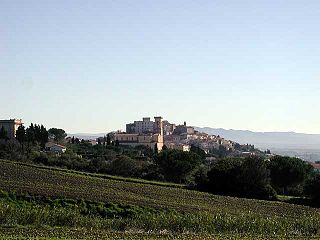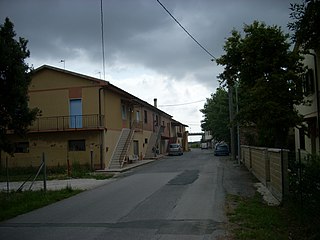Silvano is a dramma marinaresco or opera in two acts by Pietro Mascagni, 1895, from a libretto by Giovanni Targioni-Tozzetti, based on a novel by Alphonse Karr. It received its first performance on 25 March 1895 at La Scala, Milan. Although rarely performed today, the music is of some technical accomplishment, and when revived Silvano has been favourably received. The barcarolle from Silvano features prominently in a montage during the Martin Scorsese film Raging Bull.

Collesalvetti is a comune (municipality) in the Province of Livorno in the Italian region Tuscany, located about 70 kilometres (43 mi) southwest of Florence, 20 kilometres (12 mi) northeast of Livorno and only 16 kilometres (10 mi) south from Pisa.

Rosignano Marittimo is a comune (municipality) in the Province of Livorno in the Italian region Tuscany, located about 80 kilometres southwest of Florence and about 20 kilometres (12 mi) southeast of Livorno.

Mortaiolo is a hamlet in the comune of Collesalvetti, located near Vicarello.

Lo Scolmatore dell'Arno is a 28 kilometers (17 mi) artificial flood control channel of the river Arno from Pontedera to the Ligurian Sea at Calambrone. As a consequence of the Arno flood of 1949, it was decided to start the construction of Scolmatore dell'Arno in 1954 at a cost of more than 10 billion lire of the time. The work was not completed in time for the disastrous flood of 1966 that, in addition to Florence, caused enormous damages in Pontedera and Pisa.

Pisa Centrale railway station is the central station of the Italian city of Pisa, the first station of the city in terms of passengers, before Pisa-San Rossore railway station. The station is one of the major railway junctions of Tuscany. Lines serving the station include three long-distance lines: the Pisa–Livorno–Rome line, the Pisa–La Spezia–Genoa line and the Pisa–Florence line. Local services operate on the Lucca–Pisa line. The line from Pisa to Vada via Collesalvetti, which was closed from 1992 to 2000, is now only open for freight traffic.

Livorno Centrale railway station is the main station of the Italian city of Livorno. It is situated in the Piazza Dante on the eastern edge of the town. It is on the Pisa–Livorno–Rome line and handles nearly 5,300,000 passengers annually. Trains of various types stop at the station, including Inter-city and Eurostar.

The Pisa–Lucca railway is a line that was built in 1846 connecting the Tuscan cities of Pisa and Lucca. It is fully electrified at 3,000 V DC. Passenger traffic is managed by Trenitalia.

The Livorno–Rome railway is one of the trunk lines of the Italian railway network. It connects Italy’s northwest with its south, running along the Tyrrhenian coast between the Italian regions of Tuscany and Lazio, through the provinces of Livorno, Grosseto, Viterbo and Rome. The line is double track and is fully electrified at 3,000 V DC. Passenger traffic is managed by Trenitalia.
Carlo Servolini was an Italian artist from Livorno, in Tuscany. He worked in oils, water-colour, etching and lithography. He was the father of the wood engraver Luigi Servolini.
Corrado Michelozzi was an Italian painter, active in Livorno in a Divisionist style, mainly depicting still lifes with floral and fruit arrangements.
Manlio Martinelli (1884–1974) was an Italian painter active in Livorno.

Stagno is a town in Tuscany, central Italy, administratively a frazione of the comune of Collesalvetti, province of Livorno. At the time of the 2011 census its population was 4,370.

Colognole is a village in Tuscany, central Italy, administratively a frazione of the comune of Collesalvetti, province of Livorno. At the time of the 2011 census its population was 154.

Vicarello is a town in Tuscany, central Italy, administratively a frazione of the comune of Collesalvetti, province of Livorno. At the time of the 2011 census its population was 3,106.

Nugola is a town in Tuscany, central Italy, administratively a frazione of the comune of Collesalvetti, province of Livorno. At the time of the 2011 census its population was 874.

Castell'Anselmo is a village in Tuscany, central Italy, administratively a frazione of the comune of Collesalvetti, province of Livorno. At the time of the 2011 census its population was 234.

Parrana San Martino is a village in Tuscany, central Italy, administratively a frazione of the comune of Collesalvetti, province of Livorno. At the time of the 2011 census its population was 217.

Parrana San Giusto is a village in Tuscany, central Italy, administratively a frazione of the comune of Collesalvetti, province of Livorno. At the time of the 2011 census its population was 76.













